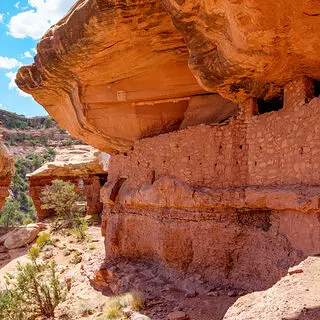
"The Spirits Are Still There": A Personal Reflection on Bears Ears National Monument
Mark Maryboy, an activist and advocate for Bears Ears National Monument, has a long history working with local, state, and federal governments to ensure that this significant cultural landscape is protected. From becoming the first Navajo County Commissioner in San Juan in 1986, to working with the U.S. government and the Obama administration to safeguard Bears Ears as a national monument, his personal and professional experiences give him a unique lens into the importance of protecting a vital representation of Native American life, culture, and history.

photo by: Mason Cummings
Do you have any personal stories to share about your connection with Bears Ears?
My grandfather was born in Bears Ears in the early 1800s. He was the leader of the Navajo, and his name was Chief Manuelito. He went on the long walk to Fort Sumner, New Mexico, and he signed the treaty [in 1868, which ended imprisonment in United States internment camps and established a reservation for the Navajo].
We—my dad, my mom, and my family—lived in the Bears Ears region during the late 1950s. My dad worked in the uranium mines there. And in 1968, when Robert F. Kennedy was running for president, he met with some Navajos. I was just a young man, but I had the opportunity to participate in the meeting. That was the first time I heard our elders speak about protecting Bears Ears.
What has been your professional experience in working with Bears Ears?
In 2010, I had the opportunity to work with former Senator Bob Bennett, whose goal was to make a decision about the longstanding public lands dispute. That was when I started working with the Utah Navajos. Our first task was to write a book about Bears Ears, so I interviewed more than 80 tribe elders with knowledge of land use, herb gathering, ceremonial places, ancient sites, and paleontology. That’s how we created the boundary for Bears Ears.
Unfortunately, we soon came to realize that the county officials and Congress were not able to work effectively with Native American tribes. Instead of supporting the legislative council, we decided to work with the Obama administration through the Antiquities Act. And from the day President Obama signed the legislation into making Bears Ears a national monument, they’ve been fighting us. They’ve been trying to rescind or downsize the monument.

photo by: Bob Wick
If you could say one thing to Secretary Zinke, what would it be?
Meet and work with the tribe. Tribal leaders have government-to-government consultation authority, according to the United States government [Consultation and Coordination with Indian Tribal Governments, an executive order signed by President Bill Clinton in 2000]. Tribal governments have sovereignty, and Zinke hasn’t acknowledged this.
Why is it important to keep Bears Ears a national monument?
In our tribe, our language, our culture, and our way of life are connected with the environment. Bears Ears is one of the last undisturbed areas our people have. We believe the spirits of the people who lived there are still there. And it’s full of historic, archeological, and paleontological sites, and biological and ecological species that need protection. For those reasons, it’s very important that we protect the earth, the plants, and special ceremonial places in Bears Ears for future generations—not just for Native Americans, but for everybody.
Donate Today to Help Save the Places Where Our History Happened.
Donate to the National Trust for Historic Preservation today and you'll help preserve places that tell our stories, reflect our culture, and shape our shared American experience.



